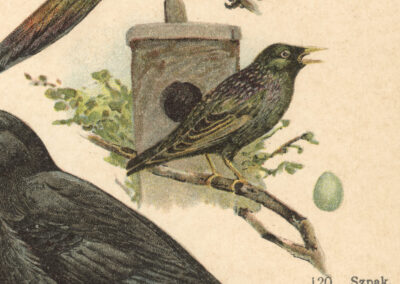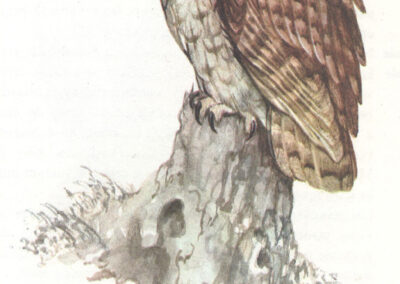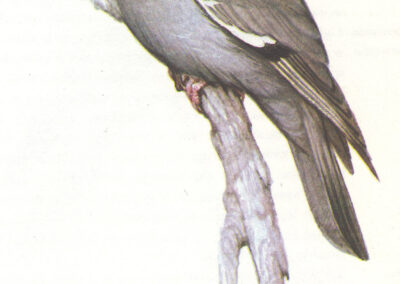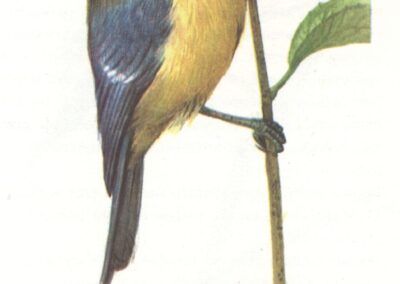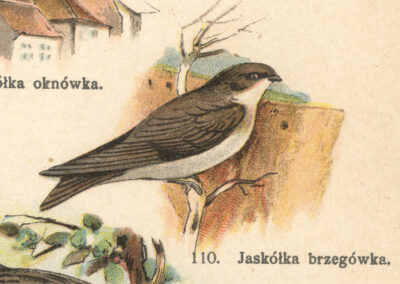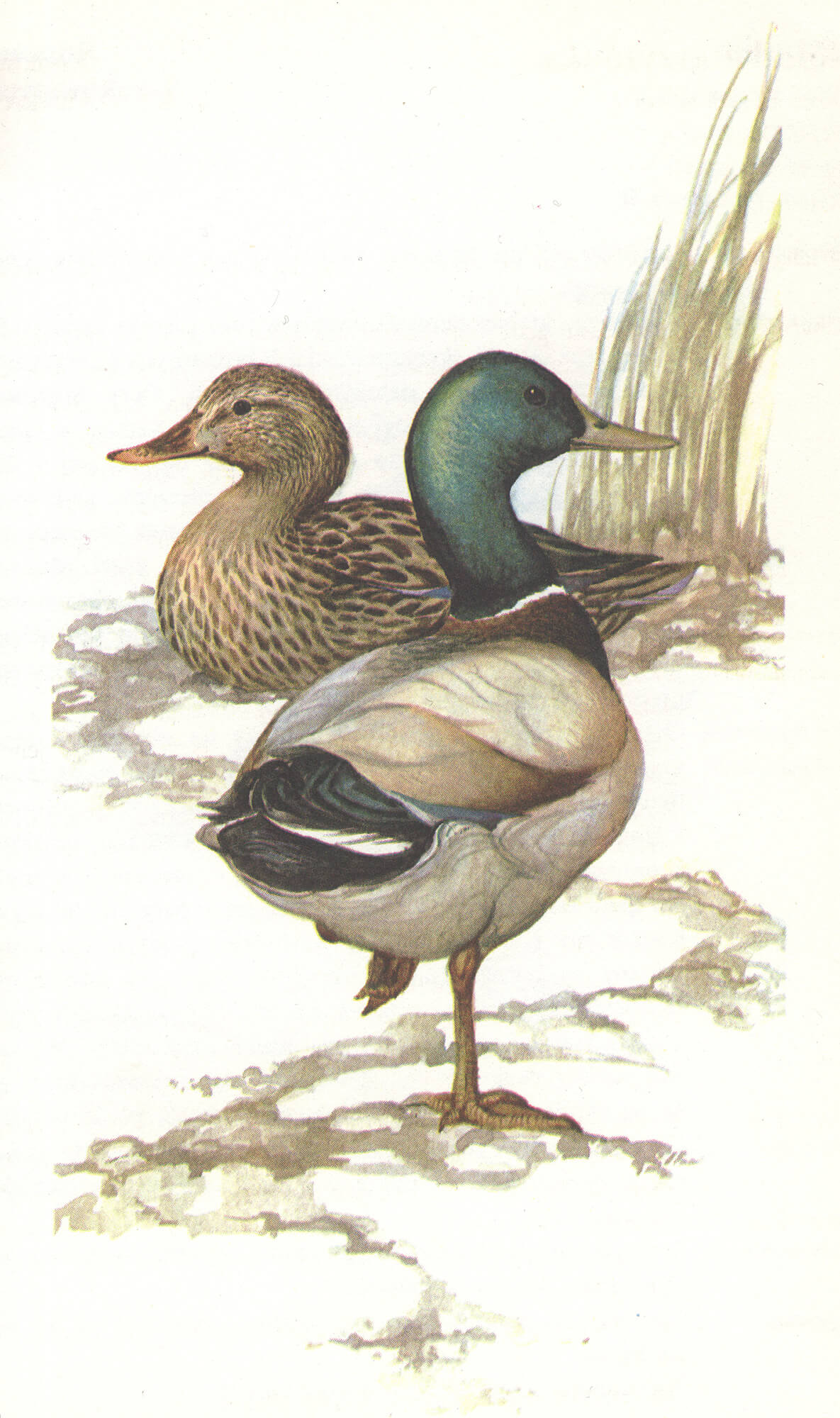
x
Birds
The 37-acre Park hosts an incredibly rich and valuable avifauna. It is inhabited by as many as 47 species of wild birds, including 37 nesting birds and another six are most likely to be breeding irregularly. The density of the nesting birds is estimated at 109–144 couples per 25 acres of land. The core of the nesting avifauna consists of species typical for deciduous forests. The most numerous breeding species are: starlings, fieldfares, chaffinches, blackcaps, song thrushes, common blackbirds, tits, and common woodpigeons. There are also numerous robins, goldfinches, chiffchaffs, garden warblers, (medium and large) woodpeckers, nuthatches, thrush nightingales, orioles, fly catchers, tawny owls, and jays. In the lower part of the Park, visitors will find waterfowl: mallards, penduline tits, and goosanders.
The nesting species most commonly found in the Park:
European Starling (Sturnus vulgaris), family: Sturnidae. It is about 8 in long, has a wingspan of about 15 in, and weighs about 2.8 oz. The most numerous bird in the Park, also common elsewhere. Mating color: black and glossy, otherwise gray-mottled; it has a yellow bill. Young birds are gray-brown. Nests in old tree hollows. Starlings are omnivorous. Partly winters in Poland.
Fieldfare (Turdus pilaris), family: Turdidae. It is about 10 in long, has a wingspan of 15–17 in, and weighs about 2.8–4.9 oz. Gray-brown and brownish-black plumage. Nests among tree branches. Feeds on small invertebrates (insects, larvae, earthworms), seeds, and fruits. The fieldfare winters in Poland.
Chaffinch (Fringilla coelebs), family: Fringillidae. It is about 6 in long, has a wingspan of about 9.5–11 in and weighs about 0.63–1.02 oz. The plumage is multicolor in the case of males (ash-reddish with white stripes on the wings); females are olive brown. The chaffinch is one of the most commonly found birds in Poland. Its nests are located in the forks of bushes or trees near the trunk and have an inner layer of moss and grass. It feeds on invertebrates and seeds. It is migratory, arriving in March or April and departing from June through October.
Eurasian blackcap (Sylvia atricapilla), family: Sylviidae. About the size of a sparrow, the black cap is approx. 6 in long, with a wingspan of about 8 in. Ash plumage with lighter underparts. Its nests are typically built in scrub. It feeds on invertebrates and insects. It is migratory, arriving in April and departing in September or October.
Song thrush (Turdus philomelos), family: Turdidae. It is about 7–9 inches long and weighs up to about 3.5 oz. Brown, cream, and yellow plumage with clear mottling. Feeds on invertebrates (earthworms, snails), fruits, and berries. It nests in bushes and coniferous trees. It is partially migratory.
Common wood pigeon (Columba palumbus), family: Columbidae. The largest pigeon in Europe. It is 15–17 in long, has a wingspan of 30 in, and weighs about 18 oz. Ash-blue plumage with a greenish neck on the sides, which is further characteristized by rings. It nests in tree crowns, high bushes, sometimes on rock shelves or buildings. It feeds mainly on plants (seeds, berries, fruits, young leaves). It is partly migratory, arriving in March and April to leave in September and October. Wood pigeons can be hunted from August 15 through November 30.
Common Blackbird (Turdus merula), family: Turdidae. It is 9–11 in long, with a wingspan of 13–17 in, and weighs from 2.6 through 3.9 oz. Males are black with a yellow bill, whereas females are olive brown with some mottling on the breast and underparts. It feeds on insects, invertebrates, berries, and fruits. Partly migratory.
Great tit and Eurasian blue tit (Parus major, Parus caeruleus), family: Paridae. It is 5–6 in long, with a wingspan of 8.5 in, and weighs about 0.7 oz. Its head is whitish-black, the breast and underparts are yellow with a black stripe. The Eurasian blue tit is slightly smaller. Its head and tail are blue, while the breast and underparts are yellow. Tits feed on insects, spiders, seeds, and fruits. They can be found in the Park throughout the year.
European robin (Erithacus rubecula), family: Muscicapidae. A small bird. It is 5.4 in long, with a wingspan of about 8.5 in, and weighs 0.5–0.8 oz. Olive gray plumage, with a rusty red front of the head, neck, and breast. It feeds on insects, small invertebrates, and berries. Nests in bushes on the ground or in the roots of bushes and trees. Migratory birds which arrive in March and April and leave in September and October.
European goldfinch (Carduelis carduelis), family: Fringillidae. It is 4.7–5.5 in long, with a wingspan of about 9 in, and weighs about 0.5–0.6 oz. Chestnut brown upper parts, a white belly, black top of the head, and a characteristic red face. It builds its nests out of twigs, grass, and moss in the crowns of trees or high shrubs. It feeds on seeds of weeds and trees as well as on small insects (aphids, caterpillars). It is partially sedentary.
Common chiffchaff (Phylloscopus collybita), family: Phylloscopus collybita. Smaller than the sparrow, it is about 4.7 in long, has a wingspan of about 7 in and weighs less than 30 oz. Greenish gray with an olive shade and light beige underparts. It builds its nests out of leaves, twigs, and grass in dense grass, bushes, sometimes higher on tree branches. It feeds on berries, small insects, and their larvae. It is a migratory species, arriving in March and April and departing from August through October.
Eurasian nuthatch (Sitta europaea), family: Sittidae. It is about 5.5 in long, with a wingspan of ca. 9–10.5 in, and weighs about 0.6–1 oz. Gray-blue-white plumage with reddish underparts. Nests in hollows and feeds on insects, spiders, and other invertebrates, but also plants, such as seeds, nuts, and acorns. It is sedentary.
Sand Martin (Riparia riparia), family: Hirundinidae. The smallest of all swallows, it is about 5 in long, with a wingspan of about 11 in, and weighs about 0.5 oz. Gray-brown with white underparts. Nests in 20–40 in long burrows on steep banks of rivers and other water reservoirs. It feeds on insects, which it catches in flight. It is migratory, arriving in April and May and departing in August and September.
Great Spotted Woodpecker, Middle Spotted Woodpecker (Dendrocopos major, Dendrocopos medius), family: Picidae. It is about 9 in long, with a wingspan of ca. 17 in, and weighs more than 3 oz. White-black with red undertail, the male has a red spot on the back. Young birds have a red cap. It nests in carved out tree trunks and branches. It is the most commonly found woodpecker in Polish forests. It feeds on insects and their larvae as well as on cone seeds. The Middle Spotted Woodpecker is slightly smaller. They are similar in color, and the red cap is present in all individuals. Due to its small bill, it makes holes in rotten tree trunks.
European green woodpecker (Picus viridis), family: Picidae. Larger than the Great Spotted Woodpecker, it is 12.5 in long, with a wingspan of about 21 in, and weighs 6.3 oz. Green-olive-gray plumage. Nests in hollows carved in softwood. It feeds mainly on ants and their larvae, invertebrates, and fruits. It is sedentary.
Thrush nightingale (Luscinia luscinia), family: Muscicapidae. It is 6.3–7 in long, with a wingspan of around 10 inch, and weighs 0.7–1.2 oz. Rusty brown plumage with a slight olive tinge, the underparts are lighter and mottled with brown. It builds its nest of grass and leaves above the ground or in low bushes. It feeds on invertebrates, fruits, and seeds. It is migratory, arriving in April and May and departing from July through September.
Mallard (Anas platyrhynchos), family: Anatidae. A large water bird, it is about 20–25 in long, with a wingspan of about 30–40 in, and weighs approx. 30–45 oz. The male is brownish gray with a green iridescent head, whereas the brown plumage of the female is less contrastive. It builds its nest in grass, sometimes in trees. The mallard is omnivorous. It mainly feeds on water plants, but also little animals (mosquito larvae, crustaceans). It is a migratory bird, arriving from February through April and departing from August through December. It is also known to winter in cities.
Tawny Owl (Strix aluco), family: Strigidae. The most numerous and common European owl is a medium-sized bird. It is about 16–18 in long, with a wingspan of about 35–40 in, and weighs approx. 15–19 oz. Gray or brown mottled plumage. Nests in hollows, rock crevices, sometimes in attics and old chimneys. It feeds on small vertebrates (mice, voles, moles, squirrels, small birds, frogs, fish) and insects.

